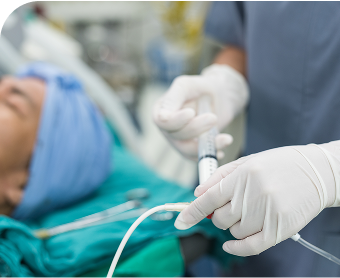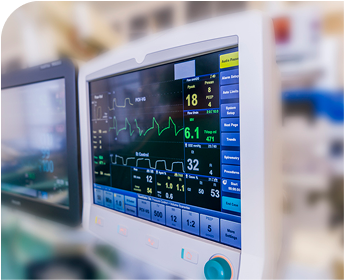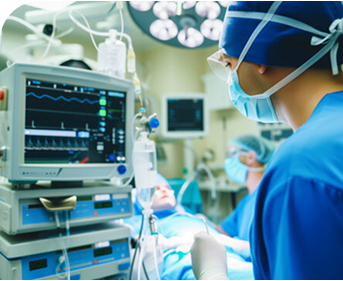


Currently, during I.V. sedation, anesthesia providers typical use oxygen masks or nasal cannulas to deliver oxygen and monitor CO2. However, both of these devices result in inferior oxygen delivery to the supraglottis and provide unreliable end tidal CO2 (ETCO2) readings due to gas mixture and dilution. The AERIS Airway™ seamlessly integrates into standard oropharyngeal (OPA) and nasopharyngeal (NPA) airways. Since the AERIS™ oxygen deliver port and CO2 detection port are offset, hypopharyngeal FIO2 reaches approximately 90% with oxygen flow rates as low as 2-4 liters per minute while simultaneously providing real-time, precise ETCO2 waveforms that enables anesthesia providers to proactively detect and respond to any signs of respiratory compromise.
The AERIS™ Kit offers seamless integration pre, intra, and post-procedure and streamlines your workflow while reducing healthcare costs. The AERIS™ Kit incorporates a detachable nasal cannula that allows the anesthesia provider to pre-oxygenate the patient prior to their procedure. Then at the start of the procedure, the detachable nasal cannula is disconnected and the O2 and CO2 lines are connected to the AERIS Airway™ to provide superior oxygen delivery and end tidal CO2 monitoring throughout the procedure. Following the procedure, the detachable nasal cannula can be reconnected to the AERIS Airway™ and the patient can be transported to PACU with supplemental oxygen.
The AERIS Airway™ is a novel airway management device designed to seamlessly integrate with standard OPAs and NPAs. During procedural sedation and post procedure, the AERIS™ transforms OPAs and NPAs into state-of-the-art oxygen (O2) delivery and real-time end-tidal carbon dioxide (ETCO2) monitoring devices. With the AERIS™ Airway, 2-4 L/min of O2 flow produces FIO2 levels approaching 80%, along with a precise capnography waveform. By providing supplemental oxygen and reliable, continuous ETCO2 readings, the AERIS™ significantly reduces the risk of hypoxia and enables early detection of respiratory compromise in sedated and post procedural patients recovering in PACU.
In addition, following a general anesthesia procedure, when you extubate the patient, you can place and OPA/AERIS Airway™ to maintain the airway while also transporting the patient to PACU with supplemental oxygen.
The AERIS Airway™ fits in all standard Guedel OPAs of sizes 80-110mm and all standard NPAs of sizes 24-36F.
The significant advantages of the AERIS Airway™ over alternative modalities include the ability to achieve FIO2 rates approaching 80% at O2 flow rates as low as 2-4 L/min while simultaneously producing a high-fidelity and precise ETCO2 waveform. That combination of features reduces the risk of patients becoming hypoxic and allows pre-emptive detection of respiratory compromise. In comparison, at O2 flow rates above 4 L/min, the FIO2 percentages for divided nasal cannulas and face masks plateau at approximately 20% and 40%, respectively. Additionally, divided nasal cannulas and face masks produce ETCO2 waveforms of lower fidelity, thereby having less clinical utility.
The AERIS Airway™ is designed for use in any procedure requiring I.V. sedation where an OPA or NPA is currently being used. Examples include, but are not limited to, pain management, peripheral arthroscopy, podiatric surgery, plastic surgery, ENT and gynecology procedures. With AERIS™, an OPA or NPA is no longer solely a device for maintaining an open airway. By combining the AERIS Airway™ with an OPA or NPA, these devices are transformed into state-of-the-art oxygen delivery and CO2 monitoring systems.
The AERIS Airway™ produces precise, high-fidelity ETCO2 waveforms at the same time that it delivers FIO2 approaching 80% because the AERIS™ has a CO2 detection port that is distal to the O2 delivery port thereby ensuring continuous, accurate, and real-time ETCO2 monitoring right at the supraglottic region with minimal dilution from the more proximal O2 flow.
Insertion of the AERIS Airway™ involves guiding the distal tip of the AERIS Airway into the central lumen of an OPA or NPA airway until the proximal hub of the AERIS™ rests on the flange of the OPA or NPA. In an OPA, the AERIS™ can be oriented so that the O2 and CO2 line connection ports are positioned either caudad or cephalad. In an NPA, due to its circular opening, the AERIS™ can be oriented in whatever position is optimal for the O2 and CO2 connection ports.
Yes, each AERIS Airway™ Kit includes a 10-foot O2 & CO2 line with universal connectors, compatible with all side-stream capnography monitors that utilize male/female luer-lock or Microstream connectors.
Since the AERIS Airway™ is a Class 1 medical device, it is considered to be low-risk device, and does not receive FDA approval. Instead, manufacturers are required to register their facility and list their devices with the FDA, follow proper labeling and Good Manufacturing Practices (GMPs) and maintain recordkeeping and reporting of any adverse events.



See how the AERIS Airway™ is changing sedation. It's the future of anesthesia care.
Request a Sample
